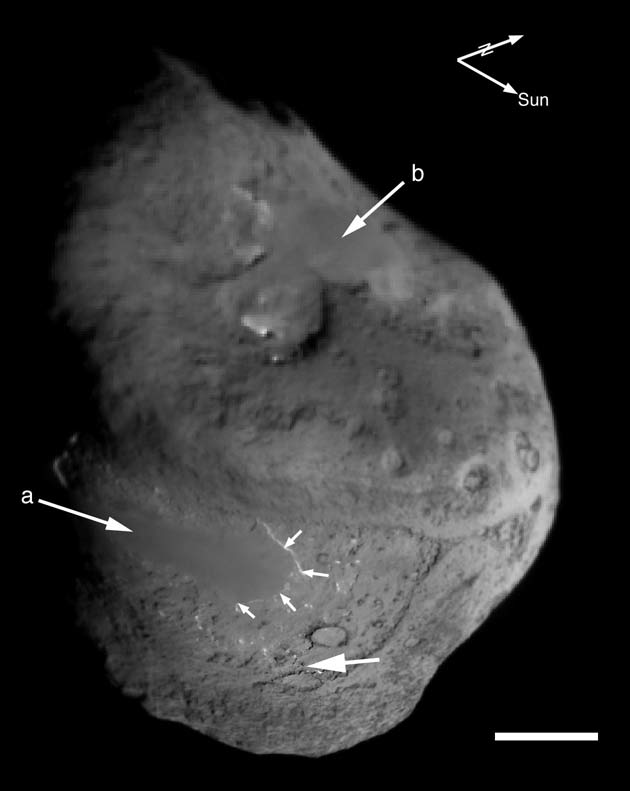Analysis: Deep Impact Comet All Fluff

The shape and surface features of the comet rammed this summer by NASA's Deep Impact probe are quite different from the two other comets whose cores have been studied, scientists said today.
Comet Tempel 1, hit in early July by an 820-pound probe, appears to be coated with fine powder rather than solid ice and rock. The powder is even finer than sand, scientists had reported shortly after the impact.
A thorough analysis confirms that and other preliminary conclusions about the 7-mile-long icy world, which appears to be rather fluffy.
Weak and porous
The outer tens of meters (yards) of the comet is less strong than a snow bank, said Deep Impact's Principal Investigator Michael A'Hearn, an astronomer at the University of Maryland.
Still, the object's gravity holds it all together.
Dust emanates from the comet in frequent outbursts, likely a result of being warmed by the Sun. The dust kicked up by the impact was not the same as surface dust, but it spread through space and dissipated in a manner similar to the natural outbursts.
Breaking space news, the latest updates on rocket launches, skywatching events and more!
While more analysis is needed, the interior is clearly different from the surface.
Inside, the comet harbors a relatively high concentration of organic compounds, the stuff from which life is made. The organics were more prevalent during and after the outburst than the water and carbon dioxide that routinely escape from the nucleus, or hard core of the comet.
The results were presented to reporters in a teleconference today and will be published later this week by the journal Science.
Comets are leftovers from the formation of the solar system. They're frozen vaults of primordial material, stuff that escaped the planet-formation process and therefore holds clues to what the raw materials of Earth and other worlds was like.
Before Deep Impact, scientists had gotten close-up looks at the nuclei of only two comets, Borelly and Wild 2. Tempel 1 is much different from either of those, yet in the grand scheme it is likely still a garden variety comet, A'Hearn and his colleagues said.
Snowy dirtball
In recent years, our impression of comets has shifted from dirty snowballs to snowy dirtballs. That latter description holds true with comet Tempel 1, A'Hearn said.
There is more dust than ice, A'Hearn said, but the ratio is less than 10-to-1. More significant to the new data is the revelation that there's not much there.
"The comet is mostly empty," A'Hearn said, adding that it is probably more than 75 percent porous with perhaps no solid core. Instead, it's likely made of ice grains loosely packed through and through.
That conclusion would not alter how comets might have delivered water and organic material to early Earth, A'Hearn said. One leading theory for the formation of life on our planet holds that the raw material was delivered by comets.
A'Hearn explained that when a comet plummets through the atmosphere, it creates a shock wave in front. Such a shock wave, not a comet's composition, is the primary factor that allows a large comet to make it to the surface intact, delivering water and organics.
A'Hearn said scientists are still analyzing the chemicals that came out of the Tempel 1, from ammonia and acetylene to hydrogen cyanide. None of the molecules are different from what previous ground-based observations had revealed, however.
Tempel 1 is also dotted with round depressions that the scientists think are impact craters, which have not been seen before on comets.
- Smashing Science: Deep Impact's Top 10 Images
- Deep Insight: Comet Buster Reveals Dusty Secrets
- Deep Impact Flyby Spacecraft Ready For New Mission
- Deep Impact: Special Report

Rob has been producing internet content since the mid-1990s. He was a writer, editor and Director of Site Operations at Space.com starting in 1999. He served as Managing Editor of LiveScience since its launch in 2004. He then oversaw news operations for the Space.com's then-parent company TechMediaNetwork's growing suite of technology, science and business news sites. Prior to joining the company, Rob was an editor at The Star-Ledger in New Jersey. He has a journalism degree from Humboldt State University in California, is an author and also writes for Medium.
